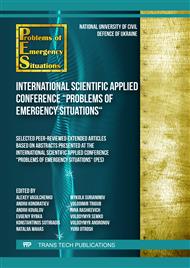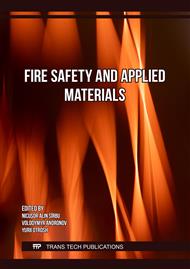[1]
SAF Ukraine (Sustainable Agribusiness Forum). URL: https://saf.org.ua/ (date of access: 20.01.2022).
Google Scholar
[2]
Roadmap 2050. URL: https://www.roadmap2050.eu/ (date of access: 20.01.2022).
Google Scholar
[3]
B. Pospelov, et al., Studying the recurrent diagrams of carbon monoxide concentration at early ignitions in premises. Eastern-European Journal of Enterprise, 3/9 (93) (2018) 34–40.
DOI: 10.15587/1729-4061.2018.133127
Google Scholar
[4]
S. Vambol et al., Research of the influence of decomposition of wastes of polymers with nano inclusions on the atmosphere, Eastern-European Journal of Enterprise Technologies, 6/10 (90) (2017) 57–64.
DOI: 10.15587/1729-4061.2017.118213
Google Scholar
[5]
O.Z. Dveirin, O.V. Andreev, A.V. Kondrat'ev, V.Ye. Haidachuk, Stressed state in the vicinity of a hole in mechanical joint of composite parts, International Applied Mechanics, 57, 2 (2021) 234–247.
DOI: 10.1007/s10778-021-01076-4
Google Scholar
[6]
S. Vambol et al., Analysis of the ways to provide ecological safety for the products of nanotechnologies throughout their life cycle, Eastern-European Journal of Enterprise Technologies, 1/10 (85) (2017) 27– 36.
DOI: 10.15587/1729-4061.2017.85847
Google Scholar
[7]
O. Rybalova et al., Development of methods for estimating the environmental risk of degradation of the surface water state, Eastern-European Journal of Enterprise Technologies, 2/10 (92) (2018) 4–17.
DOI: 10.15587/1729-4061.2018.127829
Google Scholar
[8]
V. Sadkovyi et al., Construction of a method for detecting arbitrary hazard pollutants in the atmospheric air based on the structural function of the current pollutant concentrations, Eastern-European Journal of Enterprise Technologies, 6/10 (108) (2020) 14–22.
DOI: 10.15587/1729-4061.2020.218714
Google Scholar
[9]
B. Pospelov et al., Use of uncertainty function for identification of hazardous states of atmospheric pollution vector, Eastern-European Journal of Enterprise Technologies, 2/10 (104) (2020) 6–12.
DOI: 10.15587/1729-4061.2020.200140
Google Scholar
[10]
D. Dubinin et al., Numerical simulation of the creation of a fire fighting barrier using an explosion of a combustible charge, Eastern-European Journal of Enterprise Technologies, 6/10 (90) (2017) 11– 16.
DOI: 10.15587/1729-4061.2017.114504
Google Scholar
[11]
M. I. Jahirul et al., Biofuels Production through Biomass Pyrolysis – A Technological Review, Energies, 5(12) (2012) 4952-5001.
DOI: 10.3390/en5124952
Google Scholar
[12]
D. Dubinin et al., Experimental Investigations of the Thermal Decomposition of Wood at the Time of the Fire in the Premises of Domestic Buildings, Materials Science Forum, 1066 (2022) 191–198.
DOI: 10.4028/p-8258ob
Google Scholar
[13]
B. Pospelov et al., Development of the method for rapid detection of hazardous atmospheric pollution of cities with the help of recurrence measures, Eastern-European Journal of Enterprise, 1/10 (97) (2019) 29–35.
DOI: 10.15587/1729-4061.2019.155027
Google Scholar
[14]
B. Pospelov et al., Defining the features of amplitude and phase spectra of dangerous factors of gas medium during the ignition of materials in the premises, Eastern-European Journal of Enterprise Technologies, 2/10 (116) (2022) 57–65.
DOI: 10.15587/1729-4061.2022.254500
Google Scholar
[15]
Y. Danchenko et al., Research into surface properties of disperse fillers based on plant raw materials, Eastern-European Journal of Enterprise Technologies, 5/12 (89) (2017) 20–26.
DOI: 10.15587/1729-4061.2017.111350
Google Scholar
[16]
B. Pospelov et al., Development of the method of operational forecasting of fire in the premises of objects under real conditions, Eastern-European Journal of Enterprise, 2/10 (110) (2021) 43–50.
DOI: 10.15587/1729-4061.2021.226692
Google Scholar
[17]
B. Pospelov et al., Short-term fire forecast based on air state gain recurrency and zero-order Brown model, Eastern-European Journal of Enterprise Technologies, 3/10 (111) (2021) 27–33.
DOI: 10.15587/1729-4061.2021.233606
Google Scholar
[18]
V. Sadkovyi et al., Development of a method for assessing the reliability of fire detection in premises, Eastern-European Journal of Enterprise Technologies, 3/10 (117) (2022) 56–62.
DOI: 10.15587/1729-4061.2022.259493
Google Scholar
[19]
B. Pospelov et al., Mathematical model of determining a risk to the human health along with the detection of hazardous states of urban atmosphere pollution based on measuring the current concentrations of pollutants, Eastern-European Journal of Enterprise, 4/10 (106) (2020) 37–44.
DOI: 10.15587/1729-4061.2020.210059
Google Scholar
[20]
S. Ragimov et al., Physical modelling of changes in the energy impact on a worker taking into account high-temperature radiation, Journal of Achievements of Materials and Manufacturing Engineering, 1(91) (2018) 27– 33.
DOI: 10.5604/01.3001.0012.9654
Google Scholar
[21]
D. Dubinin et al., Research and justification of the time for conducting operational actions by fire and rescue units to rescue people in a fire | Istraživanje i opravdanje vremena izvođenja operativnih akcija vatrogasno-spasilačkih postrojbi za spašavanje ljudi u požaru, Sigurnost, 64 (1) (2022) 35– 46.
DOI: 10.31306/s.64.1.5
Google Scholar
[22]
D. Dubinin et al., Investigation of the effect of carbon monoxide on people in case of fire in a building | Ispitivanje djelovanja ugljičnog monoksida na ljude u slučaju požara u zgradi, Sigurnost, 62 (4) (2020) 347– 357.
DOI: 10.31306/s.62.4.2
Google Scholar
[23]
NFPA 921. Guide for Fire and Explosion Investigations. Massachusetts, 2017 [USA].
Google Scholar
[24]
B. Pospelov et al., Short-term forecast of fire in the premises based on modification of the Brown's zero-order model, Eastern-European Journal of Enterprise, 4/10 (112) (2021) 52–58.
DOI: 10.15587/1729-4061.2021.238555
Google Scholar
[25]
D. D. Karyaparambil et al., Flame heights and charring on a particle board – An experimental study, Fire Safety Journal, 134 (2022) 103675.
DOI: 10.1016/j.firesaf.2022.103675
Google Scholar
[26]
X. Sun et al., Temperature evolution and external flame height through the opening of fire compartment: Scale effect on heat/mass transfer and revisited models, International Journal of Thermal Sciences, 164 (2021) 106849.
DOI: 10.1016/j.ijthermalsci.2021.106849
Google Scholar
[27]
Q. Lv, W. Wang, Y. Liu, Charring depth and charring rate of cross-laminated bamboo slabs exposed to a one-sided standard fire, Fire Safety Journal, 125 (2021) 103439.
DOI: 10.1016/j.firesaf.2021.103439
Google Scholar
[28]
J. Liblik, M. Nurk, A. Just, Charring performance of timber structures protected by traditional lime-based plasters, Construction and Building Materials, 347 (2022) 128572.
DOI: 10.1016/j.conbuildmat.2022.128572
Google Scholar
[29]
J. Xiao et al., Ablation behavior studies of charring materials with different thickness and heat flux intensity, Case Studies in Thermal Engineering, 23 (2021) 100814.
DOI: 10.1016/j.csite.2020.100814
Google Scholar
[30]
DSTU EN 300:2008. Plyty derevynnostruzhkovi z orijentovanoju struzhkoju (OSB). Terminy ta vyznachennja ponjat', klasyfikacija ta tehnichni vymogy (EN 300:2006, IDT). Kyiv, 2008 [in Ukrainian].
Google Scholar
[31]
DSTU GOST 10632:2009 Plyty derevynno-struzhkovi. Tehnichni umovy (GOST 10632-2007, IDT). Kyiv, 2009 [in Ukrainian].
Google Scholar
[32]
A. Kondratiev, V. Pistek, L. Smovziuk, M. Shevtsova, A. Fomina, P. Kucera, A. Prokop, Effects of the temperature-time regime of curing of composite patch on repair process efficiency. Polym., 13(24) (2021) 4342.
DOI: 10.3390/polym13244342
Google Scholar
[33]
T. D. H. Le, M.-T. K. Tsai, Experimental Assessment of the Fire Resistance Mechanisms of Timber–Steel Composites, Materials, 12(23) (2019) 4003.
DOI: 10.3390/ma12234003
Google Scholar
[34]
K. Afanasenko et al., Epoxidized Dinaphthol Application as the Basis for Binder with Advanced Carbonation Level to Reducing its Flammability, Materials Science Forum, 1006 (2020) 41–46.
DOI: 10.4028/www.scientific.net/msf.1006.41
Google Scholar
[35]
A. Kovalov et al., Treatment of Determination Method for Strength Characteristics of Reinforcing Steel by Using Thread Cutting Method after Temperature Influence, Materials Science Forum, 1006 (2020) 179–184.
DOI: 10.4028/www.scientific.net/msf.1006.179
Google Scholar
[36]
V. Sadkovyi et al., Fire resistance of reinforced concrete and steel structures, Kharkiv: РС ТЕСHNOLOGY СЕNTЕR, (2021) 180.
Google Scholar
[37]
Y. Otrosh et al., Assessment of the technical state and the possibility of its control for the further safe operation of building structures of mining facilities, E3S Web of Conferences, 123(3): (2019) 01012.
DOI: 10.1051/e3sconf/201912301012
Google Scholar
[38]
Y. Danchenko et al., Research of the intramolecular interactions and structure in epoxyamine composites with dispersed oxides, Eastern-European Journal of Enterprise Technologies, 6/12 (90) (2017) 4–12.
DOI: 10.15587/1729-4061.2017.118565
Google Scholar
[39]
Y. Danchenko et al., Study of the free surface energy of epoxy composites using an automated measurement system, Eastern-European Journal of Enterprise Technologies, 1/12 (91) (2018) 9–17.
DOI: 10.15587/1729-4061.2018.120998
Google Scholar
[40]
K. V. Korytchenko et al., Enhancing the Fire Resistance of Concrete Structures by Applying Fire-Retardant Temperature-Resistant Metal Coatings, Materials Science Forum, 1038 (2021) 500-505.
DOI: 10.4028/www.scientific.net/msf.1038.500
Google Scholar
[41]
K. V. Korytchenko et al., Advanced detonation gun application for aluminum oxide coating, Multidisciplinary journal «Functional Materials», 27 (1) (2020) 224-229.
Google Scholar
[42]
A. V. Kondratiev, V. E. Gaidachuk, Mathematical analysis of technological parameters for producing superfine prepregs by flattening carbon fibers, Mechanics of Composite Materials, 57, 1 (2021) 91–100.
DOI: 10.1007/s11029-021-09936-3
Google Scholar
[43]
D. Dubinin et al., Improving the installation for fire extinguishing with finely-dispersed water, Eastern-European Journal of Enterprise Technologies, 2/10 (92) (2018) 38– 43.
DOI: 10.15587/1729-4061.2018.127865
Google Scholar
[44]
K. Korytchenko et al., Experimental investigation of the fire-extinguishing system with a gas-detonation charge for fluid acceleration, Eastern-European Journal of Enterprise Technologies, 3/5 (93) (2018) 47– 54.
Google Scholar
[45]
A. Kasimov et al., Numerical study of the process of compressing a turbulized two-temperature air charge in the diesel engine, Eastern-European Journal of Enterprise Technologies, 6/5 (96) (2018) 49– 53.
DOI: 10.15587/1729-4061.2018.150376
Google Scholar
[46]
K. Korytchenko et al., Numerical simulation of initial pressure effect on energy input in spark discharge in nitrogen, Problems of Atomic Science and Technology, 122 (4) (2019) 116–119.
DOI: 10.46813/2019-122-116
Google Scholar
[47]
K. Korytchenko et al., Experimental research into the influence of twospark ignition on the deflagration to detonation transition process in a detonation tube, Eastern-European Journal of Enterprise Technologies, 4/5 (100) (2019) 26– 31.
DOI: 10.15587/1729-4061.2019.175333
Google Scholar
[48]
K. Korytchenko et al., Experimental investigation of arc column expansion generated by high-energy spark ignition system, Problems of Atomic Science and Technology, 118 (9) (2018) 225–228.
Google Scholar
[49]
K. Korytchenko et al., Challenges of energy measurements of low-energy spark discharges, 2020 IEEE KhPI Week on Advanced Technology (KhPIWeek), (2020) 421–424.
DOI: 10.1109/khpiweek51551.2020.9250172
Google Scholar



